Abstract
Marine buoys need to operate in high sea areas far from land for a long time. Therefore, how to provide a long-term power supply for the buoy system is critical to be addressed. Photovoltaic (PV) power supply systems are the most commonly used power supply method for marine buoys. Due to the limitations of the buoy structure and considering the rotation of the buoy in the ocean, most of the PV modules are placed in a four-sided enclosure. The output performance of the PV power supply system in this placement is affected by the tilt angle produced by waves. However, there are few relevant studies on the actual power generation performance of PV power supply systems for marine buoys, and there is a lack of methods for power generation performance analysis. In order to meet the power requirements of the marine buoy, a large design margin must be left. It increases the cost of marine buoys. In this paper, second-order Stokes waves are used to simulate waves of different levels by varying the wave height and frequency. The motion characteristics of the marine buoy are analyzed using ANSYS-AQWA under calm-rippled, smooth, slight, and moderate conditions. Combined with the tilted surface irradiance calculation model to get the variation law of solar radiation of PV modules under dynamic conditions, the effect of different tilt angle PV modules on the output of PV system under dynamic conditions was also studied. The experiments show that for every 5° increase in the tilt angle of the PV modules the output power of the system decreases by 3% on average. As the tilt angle of the PV modules increases, the impact on the system output performance is more pronounced. The output power decreased by 69.5% when the PV modules were tilted at an angle of 90°, and the PV system electrical parameters were similarly affected. By comparing the influence of different tilt angles on the power supply performance of PV modules, we optimize the design of the PV power supply system of the buoy. This enables the designers to maximize the use of limited area and space while reducing the cost and extending the power supply time and service life of the buoy.
1. Introduction
A marine buoy refers to a float on the sea surface, traditionally used to show a navigable channel or to indicate reefs, submerged wrecks, etc. [1] Since the 1920s, it has been an important platform for hosting a wide range of monitoring devices [2]. Their in situ measurement data are becoming increasingly important in disaster prevention, resource development, scientific research, and national security [3,4]. With modern technologies, buoys have become more versatile and smarter. The applications of marine buoys are extensive and rapidly being boosted [5,6].
Since marine buoys need to work in the sea far away from land for a long time, how to power the system on the buoy is a key issue to be solved. In fact, powering the distributed devices off the grid has always been a bottleneck problem [7]. PV power supply systems have been widely used because of their advantages, such as simple installation, low cost, and mature technology [8]. Existing PV power supply systems for the marine buoy have been designed according to PV systems on land. The solar power generation is roughly estimated according to the structure and space of the platform installed on the buoy. However, the environment on the buoy is very different from that on land. The effect of the wave environment on the photovoltaic system cannot be ignored. Zhang Hao et al. [9] designed a PV power supply system for the buoy with a maximum power consumption of 0.028 kWh per day, using four PV panels with a rated power of 100 W. However, they did not calculate the power generation of each unit in detail, nor did they consider the influence of the installation angles. Tomisa et al. [10] used two sets of PV modules placed horizontally and vertically, respectively, to power the buoy. Although the total rated power reached 800 W, the actual power was only a quarter. Muller, P. et al. [11] considered the rotation of the buoy when designing the PV power supply system and used a structure with adjustable module angles. However, they did not quantitatively consider the effect of the variation of the tilt angle on the power generation performance of the components. Zhou et al. [12] designed a water quality monitoring buoy for emergency response to offshore marine pollution. The power supply system was powered by a combination of solar energy and storage batteries. However, the design of the PV power supply system only considers the charging efficiency and the effective sunshine time. The power generation of PV modules depends on the solar radiation received by the surface. Due to the limitations of the structure and environment of marine buoys, it is impossible to install directly in the best orientation and angle on land, so it is necessary to carry out a comprehensive design of the installation form and angle of PV modules to obtain the maximum possible solar radiation energy. Mondol et al. [13] studied the influence of array inclination and orientation on PV power supply system under marine climate conditions and showed the change of annual total sunshine under different azimuth and inclination through TRYNSYS simulation. According to the literature, the surface facing south and with an inclination angle of 30° has the largest annual sunshine amount. The study also showed that the tilt angle has a much greater effect on the solar energy received by the surface than orientation. However, the effect of wave response on the PV module is not considered in this literature. The working environment of the buoy PV power supply system in this paper is similar to that of the recent offshore floating PV power supply system. Bugeja et al. [14] studied the effects of yaw, roll, and pitch motion on PV modules at a fixed angle, but only studied the modules at tilt angles of 0° and 30°, and concluded that roll motion has the greatest impact on the modules. Pitch motion is the second, and yaw motion is the least. Golroodbari et al. [15] simulated and compared the performance of offshore and terrestrial PV power supply systems, taking into account the effects of ocean waves, wind speed, and relative humidity in their model. The method of calculating the tilt angle of the floating body on wave energy is introduced and verified by simulation in the paper. A series of studies have shown that the average annual electricity generation of offshore systems is 12.96% better than that of land systems. Yadav and Chandel [16] introduced the calculation method of the optimal tilt angle of fixed PV arrays and proposed that in addition to the continuity and uniformity of irradiance, economy should also be considered when selecting the optimal tilt angle. Zhen-Long Wu et al. [17] used Matlab to build the solar radiation receiving model of PV modules placed on tilted surfaces, calculated the radiant energy, and deduced the annual and seasonal optimal tilt angle of PV modules. Abd Elaziz et al. [18] proposed a new artificial intelligence method to optimize the performance of photovoltaic/thermal collector (PVTC) and electrolytic hydrogen production (EHP) systems in terms of photovoltaic output power, photovoltaic surface cell temperature, coolant output temperature, thermoelectric efficiency, and hydrogen production rate. Ashutosh Sharma et al. [19] calculated the optimal tilt angle of different months in the Western Himalayas, and finally concluded that M-11 model was the optimal model through the comparison of multiple mathematical models, which can be used as a guide for the construction of local solar power stations. Zayed et al. [20] introduced the design criteria, optical geometric parameters, thermal performance analysis, thermodynamic optimization, and technical and economic aspects of solar disk Stirling system (SDSS). The results of the paper show that SDSS has a superior role in distributed energy systems, with a highly flexible power generation capacity of 1.0 to 38.8 kW, depending on the size, design, and solar radiation level of the disc condenser. Chi Cheng et al. [21] classified and summarized the common methods for calculating solar radiation on tilted surfaces, compared the advantages and disadvantages of different methods, and gave the applicable conditions and suggestions of the calculation methods.
The traditional design methods of buoy PV power supply systems suffer from insufficient utilization of solar energy resources increasing the cost of buoy. In addition, since the current research on solar power generation assumes a stable state like that on land, it is difficult to apply it to the PV power supply system on marine buoys under an unstable state due to buoy motions with ocean waves. Therefore, in order to improve the solar energy utilization of the system and reduce the cost of the buoy, this paper proposes a novel method to design and evaluate PV power supply systems on marine buoy considering buoy motions. Specifically, we first model hydrodynamic behavior of buoys on the sea surface based on computational fluid dynamics (CFD). The model is then simulated by ANSYS-AQWA. Based on the simulation, we calculate the solar irradiance of the PV system on buoys with motions and analyze the power generation performance at various wave levels. To validate the simulation results, we carry out experiments in a simulation platform where a PV power supply system is fixed on a motion equipment simulating the motion of buoy on the sea. Different from the traditional design method, this paper considers the motion of buoy and its impact on the performance of the PV power supply system. The results of the paper are important for improving and predicting the output performance of marine buoy PV systems and optimizing the design of marine buoys.
2. The Model of Solar Irradiance on the Marine Buoy
The PV power supply system on the marine buoy is a non-tracking photovoltaic system, which has a fixed tilt angle and installation position when the buoy is designed and installed. However, due to the marine environment of the buoy, the PV module on the buoy does not always stay in the designed angle and direction due to the response of the buoy structure to waves, which affects the solar radiation received by the PV module. On this basis, the response of the buoy structure to waves is divided into three degrees of freedom: pitch, yaw, and roll. As shown in Figure 1, the changes of these three degrees of freedom will affect the change of the azimuth and tilt angle of the PV module, resulting in the change of the electrical parameters of the module.
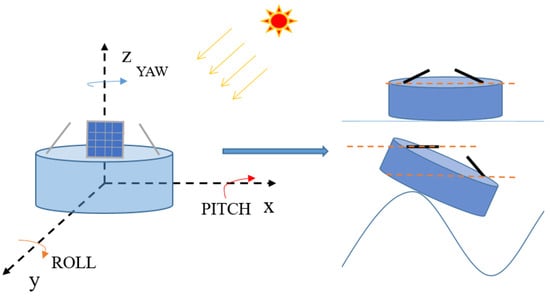
Figure 1.
Response of the buoy structure to waves.
2.1. Angle Needed to Calculate Irradiance
In this section, we introduce three angles required to calculate the irradiance of a tilted surface of a PV power supply system on a marine buoy.
- Declination Angle
The declination angle is the angle between the line between the center of the Earth and the center of the Sun and the equatorial plane, which changes with the revolution of the Sun. The common formula for calculating declination angle can be expressed by Equation (1) [22]:
N is Julian Day, which represents a certain day from January 1st.
- 2.
- Solar altitude angle
The altitude angle of the sun is the angle between the incident direction of the Sun’s ray and ground plane. It can be given by Equation (2) [23].
where is the observed Earth dimension and is the time angle which is the displacement angle of the Sun east or west from the local meridian. It can be given by Equation (3) [24].
where ST is the Solar time.
- 3.
- Solar azimuth
Solar azimuth is the angle between the projection and the southward direction of the observation site and the incidence direction of sunlight on the ground plane. It can be calculated by Equation (4).
2.2. The Model of Tilted Surface Irradiance
For the PV module whose tilt angle is and azimuth angle is , the solar irradiance received can be calculated by the following formula Equation (5) [25].
where , , and are the direct beam, diffuse and ground reflected, solar radiation components, respectively.
The calculation of the direct beam irradiance on a tilted surface, , is quite straightforward, given the measured and components, the position of the Sun, and the orientation of the surface [26]:
where is the direct irradiance conversion factor, which represents the ratio of direct normal irradiance to horizontal direct irradiance on the tilted surfaces, and is direct normal irradiance. They can be given by Equations (7)–(9).
where is the angle of sunlight incidence, the angle between sunlight and the normal line of the tilted surfaces; is the Sun altitude angle; () is the Sun zenith angle, and is the Sun azimuth angle; is the total irradiance of the horizontal plane, and is the scattered irradiance measured on the horizontal plane.
The difference between various solar radiation models is reflected in the calculation method of scattered irradiance, which has experienced a development process from isotropic to anisotropic. The isotropic model considers that the scattered radiation is only composed of the dome scattering and is uniformly distributed on the dome with the same magnitude in all directions, which is the simplest model. The most classical isotropic model is LIU and Jordan [27].
In fact, the radiation of the sky is not uniformly distributed, so an anisotropic model is needed to calculate the scattered irradiance of the tilted surfaces. The Hay model [28] is a classic anisotropic model. This model is based on isotropy considering weather factors and introducing an anisotropy index , which increased the amount of calculation but greatly improved the accuracy.
where is the solar irradiance at the upper boundary of the Earth’s atmosphere which can be calculated from Equation (13). In the clear sky condition, the anisotropy index is larger. In cloudy weather, the anisotropy index goes to zero and all diffuses are treated as isotropic.
The Perez anisotropic model is recognized as the most accurate model [29]. The scattered radiation is divided into three parts: isotropic dome scattering, disc scattering, and scattering representing the brightness of the horizontal plane. Its calculation formula is shown in Equation (14).
where is the correction conversion factor of direct irradiance; is the content parameter of the disc radiation; is the content parameter of the horizontal plane brightness radiation, and they can be calculated from the atmospheric parameters.
The common method to calculate the reflected irradiance of all directions incident on a sloping surface is to assume that there is a diffuse reflection region around the sloping surface and the horizontal line is smooth, so that the reflection of the water surface is diffuse, which can be obtained by the formula proposed by Duffie and Beckman [30]:
where is the reflectivity of the water surface, and for the open sea reflectivity, .
Hafez et al. [31] and Bugeja et al. [14] compared different irradiance calculation models in terms of computational accuracy and complexity and validated them experimentally. The results show that Perez anisotropic model has the highest accuracy, Hay model is slightly lower, and LIU and Jordan model is the worst. However, the Perez anisotropic model is difficult to calculate due to the introduction of many parameters. Considering accuracy and complexity, the Hay model is used in this paper.
3. Performance Analysis of PV Power System with the Motion of Marine Buoy
In this section, we first construct a buoy model and simulate its motion behavior on the sea surface by ANSYS-AQWA. Then, we analyze the solar irradiance and power generation performance of the PV power system on the buoy with motions at various wave levels.
3.1. Motion Equation of the Buoy and Buoy Structure
In this paper, the motion state response of a marine buoy in the time domain considering the effect of wave loads is investigated using the ANSYS-AQWA. ANSYS-AQWA is a very powerful tool that can help researchers and developers to perform a wide range of fluid analyses [32,33]. Based on ANSYS-AQWA, researchers can efficiently conduct hydrodynamic analysis of marine buoys and the system can be effectively integrated with a comprehensive consideration of random environmental loads: wind, current, wave, surge load, and propulsion effect [34]. The effects of other factors on marine buoy PV systems can be more easily analyzed in future studies.
According to the potential flow theory, the fluid is assumed to be irrotational, inviscid, and incompressible. In the computational domain, the buoy motion characteristics are expressed as simple harmonic motion with fluctuations. The buoy’s motion is calculated in the time domain. It can be calculated by the following matrix equation [35]:
where is the mass matrix, , is the buoy’s mass, and is the buoy’s rotational inertia; is the added mass matrix at finite frequency; is the displacement amplitude matrix; is the retardation function matrix in the time domain; is the hydrodynamic stiffness matrix, , is the sea water density, is the acceleration of gravity, is the buoy’s base area, , , is the buoy’s volume; is the hydrodynamic excitation force matrix; is the second order wave force matrix;
and can be calculated as [36]:
where is the wave frequency, is the added mass matrix, is the radiation damping matrix. Based on ANSYS-AQWA, Eden et al. of California established the energy conversion model of five-section buoys. The capture energy behavior was optimized considering different wave conditions and buoy sizes. Luo [37] of Harbin Institute of Technology analyzed the systematic factors such as buoy size, flood depth, wave period, damping, etc. based on AQWA, and obtained the specific relationship between the above systematic factors and trap energy behavior.
Most of the marine buoys are cylindrical in shape [38]. Since the cylindrical top surface area is large and the height is relatively small, it can provide enough space for the equipment and facilitate maintenance [11]. Their PV power supply system is placed on the platform on the cylindrical base. Considering the rotation of buoy, the solar panels are usually placed around the four sides of the buoy. Therefore, the marine buoy model is designed as a combination of a cylinder and a prism. The buoy structure and grids on the buoy surface in ANSYS-AQWA are shown in Figure 2 and the specific parameters are shown in Table 1.
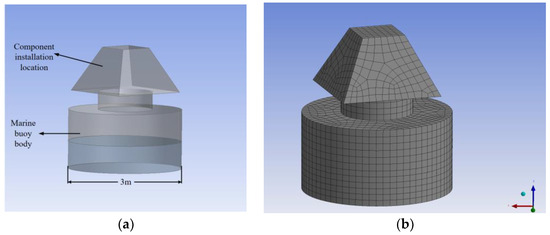
Figure 2.
Marine buoy structure diagram and its model in ANSYS-AQWA. (a) Buoy structure (b) Grids on the buoy surface in ANSYS-AQWA.

Table 1.
Main parameters of buoy by ANSYS-AQWA.
3.2. Simulation of Buoy Motion and Analysis of Solar Irradiance
Under the influence of the regular wave in the X-axis direction, the floating body motion is mainly horizontal in the X-axis direction, rotation around the Y-axis (Roll), and hewing motion in the Z-axis direction. The rotational of the Y-axis, namely the rolling motion, is the main reason for changes of the tilt angle of the PV module affecting the solar irradiance accepted by the module. As the marine buoy is an axisymmetric structure and the PV modules are symmetrically placed on the float, the rolling motion and the pitch motion have the same effect on the tilt angle of the PV modules. As pointed out in [39,40], heaving and yawing have a very weak effect on the tilt angle of PV systems. Therefore, this paper only studies the effect of the rolling motion on the marine buoy PV system. The influence process is illustrated in Figure 3. When the wave in the X-axis direction mainly affects the tilt angle of module 1 and 2, the influence on the tilt angle of module 3 and 4 can be ignored. In order to obtain the motion characteristics of the buoy under the wave action, the hydrodynamic analysis software ANSYS-AQWA is used to simulate it.
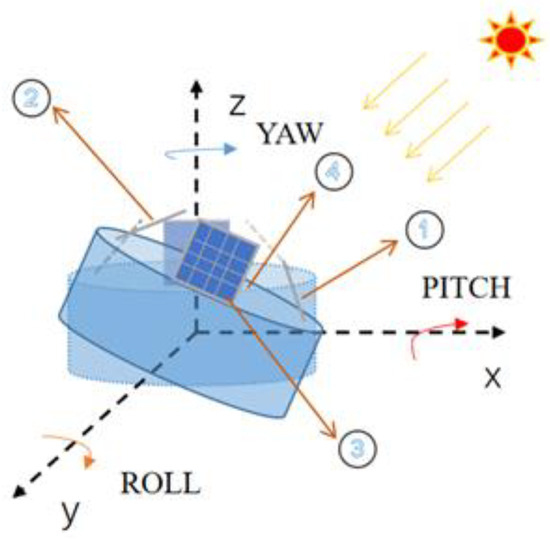
Figure 3.
Effect of rolling motion on buoy attitude.
In this paper, the second-order Stokes wave is used to simulate ocean waves, and different levels of waves are simulated by changing their wave height and frequency. The wave heights and periods of different waves are listed in Table 2. The probability of different levels of waves in a Chinese sea in a year is shown in Figure 4. In one year, the probability of a wave level equal and above moderate is only 4.41%, whereas the probabilities of calm-rippled, smooth, and slight levels are 31.5%, 40%, and 21.4%, respectively. The buoy operates 92.8% of the time in a year under wave levels 1–3. Therefore, this paper chooses four wave levels in the simulation, which are calm-rippled, smooth, slight, and moderate. The moderate level can be used to simulate extreme weather waves.

Table 2.
Wave heights and periods at different levels of ocean waves.
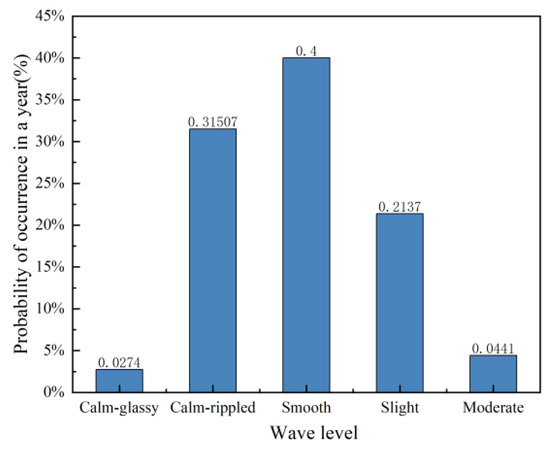
Figure 4.
Probability of wave level occurrence in a Chinese sea during a year.
In the simulation, a step of 0.01 s was used, the simulation time was 40 s, the acceleration of gravity was 9.8 N/kg, the depth of the sea was 1000 m, and the wave direction was the positive direction of the X-axis. The simulation results are shown in Figure 5. This movement changes the tilt angle of the PV modules on the buoy, which in turn changes the irradiance received by the modules.
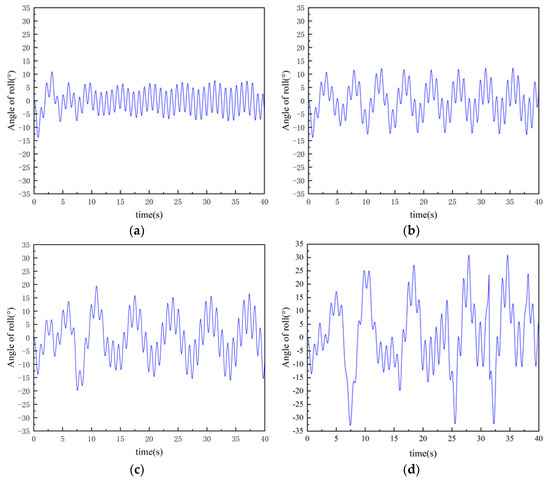
Figure 5.
The angle of the rolling motion of the buoy under different waves. (a) Calm-rippled; (b) smooth; (c) slight; (d) moderate.
As the wave level increases, the rolling angle of the buoy around the Y-axis gradually increases. The range of rolling angles in calm-rippled conditions is −7.1° to 6.8°. When the wave level is moderate, the rolling range is increased −32.3° to 31°. It can be seen that the wave level has a great influence on the motion of the buoy.
Our simulation results are in accordance with those of existing work [41,42,43]. Refs [41,42] utilized ANSYS-AQWA for CFD simulations to obtain numerical results and verified the correctness of the model through physical experiments. In addition, Jeong et al. [43] carried out a detailed hydrodynamic analysis of a lighted buoy working on the sea surface with a buoy structure similar to the one in this paper, and obtained the result that its rolling angle is ±20° under a wave with a frequency of 1.397 rad/s and a wave height of 0.794 m. The studies of these scholars provide some evidence of the correctness of the model in this paper.
Solar irradiance is calculated by using the Hay model. The variation of the radiance received by the component under different wave levels can be calculated. The main research object in this section is module 1. The observation conditions are the dimension of the observation site , the time angle , the tilt angle , and the total irradiance of the horizontal surface . In this case, module 1 irradiance variation under different waves is shown in Figure 6 and Table 3.
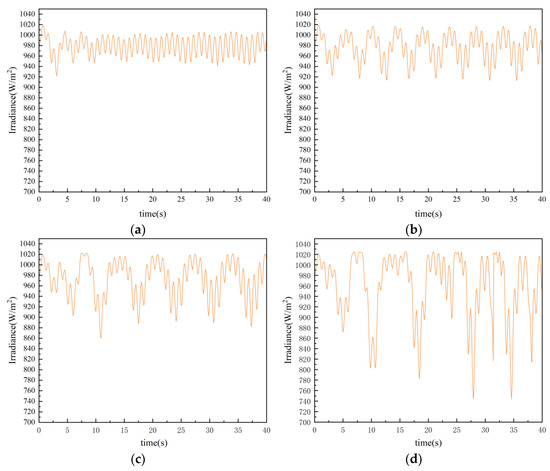
Figure 6.
Irradiance received by PV modules under various wave levels. (a) Calm-rippled; (b) smooth; (c) slight; (d) moderate.

Table 3.
Solar irradiance at various wave levels.
From the results in Figure 6, we can see that wave levels have a significant impact on the buoy PV modules. The irradiance received by the PV modules under the influence of waves shows a certain periodicity and the range of variation increases with the increase of wave level. The reason for this variation is that the motion of the waves affects the attitude of the buoy and changes the tilt angle of the PV modules. This kind of variation does not exist in land-based PV power supply systems.
The results in Table 3 show there is a 2–5% difference between the average radiation and the land standard radiation () due to the effect of waves. This means that when choosing the sea area where the marine buoy will operate, we should choose a sea area with a low wave level so that the marine buoy will remain as smooth as possible.
3.3. Power Generation Performance of Marine Buoy PV System Considering Buoy Motions
PV power generation is affected by many factors such as solar radiation, seasonal changes, sudden weather changes, load fluctuations, and the performance of PV modules themselves. Due to the variability of environmental factors, the power output of the PV system changes dynamically with time. A simple model for the power output from the PV model is given by Equation (19) [44]:
where is the PV module efficiency, is the area of the module, and is the temperature.
Since the photovoltaic modules are installed on the top of the buoy, when designing the marine buoy PV power supply system, designers have to consider the rotation of the buoy. The PV modules face four directions at the same installation angle. By using the tilt surface irradiance calculation model and the PV module power output model, we can obtain the power output of the marine buoy PV system at any tilt angle. From Equation (19), it can be seen that the power output of the PV module is strongly correlated with its received irradiance. Therefore, we can define a scale factor that has the Equation (20):
where is the maximum irradiance received by PV modules on land. The purpose of defining the scaling factor is to visualize the difference between the marine buoy PV system and the land PV system. Designers can refer to the land PV system and scaling factors to refine the design of the marine buoy PV power system. The results of the variation of scale factor with tilt angle at various wave levels are shown in Figure 7.
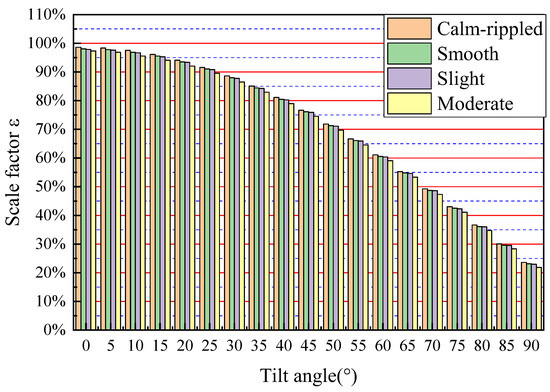
Figure 7.
Scale factors of radiation of PV modules on buoy and that on land.
The results in Figure 7 show that when PV modules are tilted at an angle of 0–30°, the scale factor varies less across different wave levels. The scale factor decreases by 1% for every 5° increase in tilt angle, which means that the effect of the marine environment on the PV system is not very significant when the tilt angle is small. In the range of 31–90°, the change in tilt angle has a greater effect on irradiance. For every 5°change in tilt angle, the scale factor decreased by 6%. In addition to the effect of tilt angle on system irradiance, wave level also impacts the irradiance received by the modules. When the installation angle is less than 30°, the scale factor at moderate level is 1% lower than that at calm-rippled level. When the installation angle exceeds 30°, the scale factor at moderate level is 2% lower than that at calm-rippled level. The effect of the wave level on the scale factor is the highest when the installation angle is 40°, when the scale factor at moderate level is 2.14% lower than that at calm-rippled level.
In summary, it is necessary to comprehensively consider the influence of PV module tilt angle and wave in the development of actual marine buoy PV system. The tilt angle of the PV modules is suggested to be a value in 0–30°, because the effect caused by the change of wave levels in this range is less, and the PV modules can accept more solar radiation to increase the output performance of the system.
4. Experimental Validation
To validate the simulation results, we carry out experiments by establishing a PV power supply system on top of a simulated buoy. The motions of buoy on the sea surface are simulated by equipment using the model in the above section. The performance of the PV power supply system is analyzed and compared with that of the simulation.
4.1. Experimental Platform
To validate the effect of tilt angle on the performance of photovoltaic power supply systems for marine buoys, a simulation platform was built in the laboratory. The photo of the platform is as shown in Figure 8. The platform includes 6-DOF motion equipment, a motion controller, and a PV power supply system. The 6-DOF motion equipment can move driven by the motion controller, simulating the buoy motion on the sea. The PV power supply system with four PV modules is fixed on the top of the motion equipment in the same patten as installation on the buoy. The PV module holder is infinitely adjustable from 0 to 90° to simulate any installation angles. Halogen lights are used to simulate sunlight. The specific parameters of the PV modules are shown in Table 4.
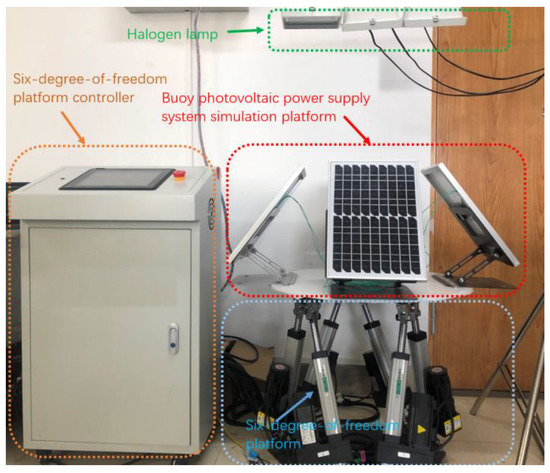
Figure 8.
Simulation platform of marine buoy photovoltaic power supply system.

Table 4.
Photovoltaic module parameters.
The maximum power point, maximum power point voltage, and current as well as open circuit voltage and short circuit current of the PV module are recorded in the experiment. The effect of tilt angle on the system is investigated by the variation of electrical parameters of the PV modules.
4.2. Effect on Module Output Power and Electrical Parameters
In this section, the effect of changing the installation angle of the PV modules on the electrical parameters was studied. It also compared the difference in power output between the marine buoy PV power system and the land PV system (south facing, optimal tilt angle). The simulated waves in the laboratory were chosen to be more gentle and weak because the waves are not particularly violent in normal weather and the buoy works for a long time in calm-rippled and smooth levels. Therefore, the variation of the output power and electrical parameters of the four modules working in a smooth environment was recorded in the experiment. To better compare the parameter variations and study the marine buoy PV power supply system, the changes in electrical parameters caused by changing the tilt angle of a single module in a smooth level were also tested. The results are shown in Figure 9 and Figure 10.
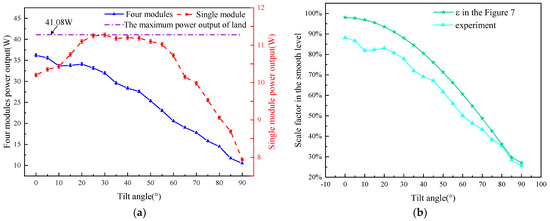
Figure 9.
(a) Power output for four modules, single module, and the maximum power output of land. (b) Scale factor in the experiment.
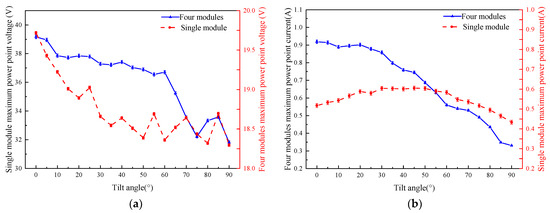

Figure 10.
PV electrical parameters as a function of tilt angle: (a) Maximum power point voltage, (b) Maximum power point current, (c) Open-circuit voltage, (d) Short-circuit current.
4.2.1. Effect on Power Output
From Figure 9a, it can be seen that the output power of the PV modules on land facing south and installed at the optimal tilt angle is 41.08 W. For a single PV module, when the tilt angle is close to 25°, the maximum output power of a single module is 11.2 W. In the range of 0–30°, the output power increases by 0.15 W for every 5° increase in the tilt angle. When the tilt angle exceeds 30°, the output power starts to decrease with the increase of tilt angle, and the larger the tilt angle is, the more pronounced the decrease is. The four modules are connected in two groups in series and then in parallel. The maximum output power is 36.2 W at the module tilt angle of 0°. As the tilt angle increases, the output power of the four modules gradually decreases. It can be seen from Figure 9 that the output power decreases by 1.2 W on average for every 5° increase in the tilt angle. The output power decreased by 69.5% when the PV modules were tilted at an angle of 90°. The reason for the different trend from the single module is that the four modules receive different irradiance due to the special placement of the modules, which will produce a local shading effect resulting in lower output power [45]. George and Anto [46] showed that a 5° change in tilt angle causes a power loss of approximately 2% or more. Adiyasuren E. [47] shows that in Mongolia, yearly rough power output generations at the module-angle 45° are 10% larger than those achieved with a tilt angle of 60°. In another experimental study, it was found that if the module angle was decreased from 50° to 10°, the module power output was increased by 26.15% [48]. Hence, the present results are concurrent with the previous research outcomes.
The scale factors in the smooth wave level obtained in the experiments are compared with those calculated theoretically in Figure 9b. The results show that they have some numerical differences, and this difference decreases with the increase of the tilt angle. However, they have the same trend, which also shows that the research method proposed in this paper to calculate the output characteristics of marine buoy PV system is correct. The reasons for the differences in values are analyzed in Section 4.2.3. It can be seen that when the buoy structure allows, we can make the PV module tilt (tilt angle is 0) on the buoy to maximize the output performance of the system. However, when the PV module has to be installed on the buoy at a large tilt angle due to the structural limitations of the buoy, the selection of the PV module is very important, because the actual power generation performance of the module and the theoretical value are different.
4.2.2. Effect on Module Electrical Parameters
Figure 10 shows the effect of the tilt angle on the electrical parameters. The maximum operating voltage, maximum operating current, open-circuit voltage, and short-circuit current of the components decrease with the increase of the tilt angle in the particular placement of the marine buoy. The trend of the maximum power point current and short-circuit current of the system is more uniform, with the maximum power point current and short-circuit current decreasing by 0.03 A and 0.035 A, respectively, for every 5° increase in the tilt angle. However, the maximum power point voltage and open-circuit voltage change more slowly when the angle is small, and when the angle increases to a certain level it will lead to a rapid decrease in these two parameters.
4.2.3. Error Analysis
There are two main reasons for possible errors in measurement data in experiments:
(1) The output power and electrical parameters of PV modules are affected by both the tilt angle and the temperature of the modules. The increase in temperature not only adversely affects the output power of the module, but also negatively affects the open-circuit voltage and the maximum power point voltage of the module [49]. The experiments in this paper were conducted indoors and used halogen lamps to generate radiation. This ensures that the irradiance received by the PV module is unchanged, but due to the reason of heat dissipation in the room, the irradiation of the halogen lamp also makes the temperature of the PV module rise rapidly. This causes errors in the measurement of the module output and electrical parameters. However, the effect of temperature on the PV module was not considered during the theoretical calculations, which is the main reason for the difference in the values in Figure 9b. Considering that the actual application environment of the research in this paper is on the sea surface, the temperature change of the PV module is not obvious, so there are some differences between this experiment numerically and in the actual application, but the trend is consistent.
(2) Errors in measuring equipment. The measurement equipment used in the experiment has a certain error in itself, with an accuracy of 0.5% for the measurement of output power and 0.1% for the measurement of other electrical parameters. The measurement error of the inclinometer, which adjusts the inclination angle of the PV module, was 0.3%.
5. Conclusions and Remarks
The PV power supply system on the marine buoy is crucial, but due to the limitations of the buoy structure and space, it cannot simply refer to the conventional design method of the onshore PV system. In contrast to the PV system installed on land, the output performance of the marine buoy PV system is affected by changes in the attitude of the buoy, resulting in a difference between the actual and theoretical output performance of the PV system. In this paper, the structure of the buoy is simulated and modeled. By studying the motion characteristics of the buoy under different wave levels, analyzing the change law of the tilt angle of the PV modules installed on the buoy, and combining the calculation model of irradiance on the tilted surface, the PV power generation characteristics of the marine buoy are investigated and the simulation results are verified through experiments.
The major conclusions of this study can be summarized as follows: (1) Due to the influence of wave excitation, the solar radiation received by the PV modules of the marine buoy will have periodic fluctuations, and the fluctuation period is related to the wave level in the sea. (2) The rolling motion of the buoy negatively affects the solar radiation received by the PV modules. There is a 2–5% difference in the irradiance received by the PV modules of the marine buoy over a period of time from the irradiance received by the fixed PV modules on land. (3) Experiments have shown that the tilt angle of the PV modules also affects the output performance of the marine buoy PV system. The output power of the system is reduced by 3% for every 5° increase in the tilt angle. Other electrical parameters also show a decreasing trend with increasing tilt angle. (4) Changes in wave size (wave height and frequency) at the same tilt angle will also affect the output performance of the system.
The tilt angle and installation position of PV modules have a great influence on their electrical performance. The research methodology presented in this paper is not only applicable to the buoys in this paper, but also to other PV systems with buoy structures. It is beneficial for the development and optimal design of PV power supply systems for buoys. In future work, this method will be extended to the study of the power generation performance of other floating PV systems beyond those on buoys.
Author Contributions
Conceptualization, C.W. and X.S.; methodology, C.W., P.C. and L.C.; software, X.S.; validation, C.W. and X.S.; formal analysis, Q.F.; investigation, X.S. and L.C; resources, C.W.; data curation, X.S.; writing—original draft preparation, X.S.; writing—review and editing, C.W. and Q.F.; visualization, X.S., Q.F. and L.C.; supervision, C.W.; project administration, C.W.; funding acquisition, C.W. All authors have read and agreed to the published version of the manuscript.
Funding
This research received no external funding.
Institutional Review Board Statement
Not applicable.
Informed Consent Statement
Not applicable.
Data Availability Statement
Not applicable.
Conflicts of Interest
The authors declare no conflict of interest.
References
- Xu, R.; Wang, H.; Xi, Z.; Wang, W.; Xu, M. Recent Progress on Wave Energy Marine Buoys. J. Mar. Sci. Eng. 2022, 10, 566. [Google Scholar] [CrossRef]
- Park, Y.W.; Kim, T.W.; Kwak, J.S.; Kim, I.K.; Park, J.E.; Ha, K.H. Design of Korean Standard Modular Buoy Body Using Polyethylene Polymer Material for Ship Safety. J. Mater. Sci. Chem. Eng. 2016, 4, 65–73. [Google Scholar] [CrossRef][Green Version]
- Canepa, E.; Pensieri, S.; Bozzano, R.; Faimali, M.; Traverso, P.; Cavaleri, L. The ODAS Italia 1 buoy: More than forty years of activity in the Ligurian Sea. Prog. Ocean. 2015, 135, 48–63. [Google Scholar] [CrossRef]
- Li, X.; Bian, Y. Modeling and prediction for the Buoy motion characteristics. Ocean Eng. 2021, 239, 109880. [Google Scholar] [CrossRef]
- Srinivasan, R.; Rajendran, V.; Zacharia, S.; Sudhakar, T.; Atmanand, M.A. Indigenized Indian Drifting Buoys with INSAT Communication for Ocean Observations. Ocean Eng. 2017, 145, 263–267. [Google Scholar] [CrossRef]
- Venkatesan, R.; Vengatesan, G.; Vedachalam, N.; Muthiah, M.A.; Lavanya, R.; Atmanand, M.A. Reliability assessment and integrity management of data buoy instruments used for monitoring the Indian Seas. Appl. Ocean Res. 2016, 54, 1–11. [Google Scholar] [CrossRef]
- Shaikh, F.K.; Zeadally, S. Energy harvesting in wireless sensor networks: A comprehensive review. Renew. Sustain. Energy Rev. 2016, 55, 1041–1054. [Google Scholar] [CrossRef]
- Khan, J.; Arsalan, M.H. Solar power technologies for sustainable electricity generation—A review. Renew. Sustain. Energy Rev. 2016, 55, 414–425. [Google Scholar] [CrossRef]
- Zhang, H.; Zhang, D.; Zhang, A. An Innovative Multifunctional Buoy Design for Monitoring Continuous Environmental Dynamics at Tianjin Port. IEEE Access 2020, 8, 171820–171833. [Google Scholar] [CrossRef]
- Tomisa, T.; Krajcar, S.; Pinezic, D. Multipurpose marine Buoy. In Proceedings of the 2008 50th International Symposium ELMAR, Borik Zadar, Croatia, 9 January 2008; pp. 401–405. [Google Scholar]
- Mueller, P.; Thoss, H.; Kaempf, L.; Güntner, A. A Buoy for Continuous Monitoring of Suspended Sediment Dynamics. Sensors 2013, 13, 13779–13801. [Google Scholar] [CrossRef]
- Zhou, H. Design and Research of Emergency Water Quality Monitoring Buoy System. Master’s Thesis, Tianjin University, Tianjin, China, 2020. [Google Scholar]
- Mondol, J.D.; Yohanis, Y.G.; Norton, B. The impact of array inclination and orientation on the performance of a grid-connected photovoltaic system. Renew. Energy 2007, 32, 118–140. [Google Scholar] [CrossRef]
- Bugeja, R.; Mule Stagno, L.; Branche, N. The effect of wave response motion on the insolation on offshore photovoltaic installations. Sol. Energy Adv. 2021, 1, 100008. [Google Scholar] [CrossRef]
- Golroodbari, S.Z.; Sark, W. Simulation of performance differences between offshore and land-based photovoltaic systems. Prog. Photovolt. Res. Appl. 2020, 28, 873–886. [Google Scholar] [CrossRef]
- Yadav, A.K.; Chandel, S.S. Tilt angle optimization to maximize incident solar radiation: A review. Renew. Sustain. Energy Rev. 2013, 23, 503–513. [Google Scholar] [CrossRef]
- Zhenlong, W.; Zheng, X.; Xiaoyan, H.; Zongxu, Q. Study on practical calculating models of irradiance intensity on tilted surfaces. Prog. Photovolt. Res. Appl. 2016, 37, 787–793. [Google Scholar]
- Abd Elaziz, M.; Senthilraja, S.; Zayed, M.E.; Elsheikh, A.H.; Mostafa, R.R.; Lu, S. A new random vector functional link integrated with mayfly optimization algorithm for performance prediction of solar photovoltaic thermal collector combined with electrolytic hydrogen production system. Appl. Therm. Eng. 2021, 193, 117055. [Google Scholar] [CrossRef]
- Sharma, A.; Kallioğlu, M.A.; Awasthi, A.; Chauhan, R.; Fekete, G.; Singh, T. Correlation formulation for optimum tilt angle for maximizing the solar radiation on solar collector in the Western Himalayan region. Case Stud. Therm. Eng. 2021, 26, 101185. [Google Scholar] [CrossRef]
- Zayed, M.E.; Zhao, J.; Elsheikh, A.H.; Li, W.; Sadek, S.; Aboelmaaref, M.M. A comprehensive review on Dish/Stirling concentrated solar power systems: Design, optical and geometrical analyses, thermal performance assessment, and applications. J. Clean. Prod. 2021, 283, 124664. [Google Scholar] [CrossRef]
- Cheng, C.; Chen, Z.H.; Sun, P.J. Advances in Calculation Method of the Optimal Tilted Angle for PV Array in Solar Resource Assessment. Adv. Meteorol. Sci. Technol. 2017, 7, 60–65. [Google Scholar]
- Lau, K.Y.; Tan, C.W.; Yatim, A.H.M. Effects of ambient temperatures, tilt angles, and orientations on hybrid photovoltaic/diesel systems under equatorial climates. Renew. Sustain. Energy Rev. 2018, 81, 2625–2636. [Google Scholar] [CrossRef]
- Kaddoura, T.O.; Ramli, M.A.M.; Al-Turki, Y.A. On the estimation of the optimum tilt angle of PV panel in Saudi Arabia. Renew. Sustain. Energy Rev. 2016, 65, 626–634. [Google Scholar] [CrossRef]
- Herrería-Alonso, S.; Suárez-González, A.; Rodríguez-Pérez, M.; Rodríguez-Rubio, R.F.; López-García, C. A Solar Altitude Angle Model for Efficient Solar Energy Predictions. Sensors 2020, 20, 1391. [Google Scholar] [CrossRef] [PubMed]
- Oh, M.; Kim, J.; Kim, B.; Yun, C.; Kim, C.K.; Kang, Y.; Kim, H. Tolerance angle concept and formula for practical optimal orientation of photovoltaic panels. Renew. Energy 2021, 167, 384–394. [Google Scholar] [CrossRef]
- Raptis, P.I.; Kazadzis, S.; Psiloglou, B.; Kouremeti, N.; Kosmopoulos, P.; Kazantzidis, A. Measurements and model simulations of solar radiation at tilted planes, towards the maximization of energy capture. Energy 2017, 130, 570–580. [Google Scholar] [CrossRef]
- Liu, B.Y.H.; Jordan, R.C. The long-term average performance of flat-plate solar-energy collectors. Sol. Energy 1963, 7, 53–74. [Google Scholar] [CrossRef]
- Hay, J.E. Calculation of monthly mean solar radiation for horizontal and inclined surfaces. Sol. Energy 1979, 23, 301–307. [Google Scholar] [CrossRef]
- Munkhammar, J.; Widén, J. Correlation modeling of instantaneous solar irradiance with applications to solar engineering. Sol. Energy 2016, 133, 14–23. [Google Scholar] [CrossRef]
- Yao, W.; Li, Z.; Zhao, Q.; Lu, Y.; Lu, R. A new anisotropic diffuse radiation model. Energy Convers. Manag. 2015, 95, 304–313. [Google Scholar] [CrossRef]
- Hafez, A.Z.; Soliman, A.; El-Metwally, K.A.; Ismail, I.M. Tilt and azimuth angles in solar energy applications—A review. Renew. Sustain. Energy Rev. 2017, 77, 147–168. [Google Scholar] [CrossRef]
- Sang, S.; Zhou, Y.; Jiang, X.L. Study on Nonlinear Motion Behavior of Coupled Heave-Pitch for the Classic Spar Platform Based on AQWA. Appl. Mech. Mater. 2012, 170–173, 2170–2174. [Google Scholar] [CrossRef]
- Wang, S.M.; Shi, F.B.; Lin, Z.N.; Zou, W. A Hydrodynamic Analysis of Offshore Platform Based on the AQWA. Appl. Mech. Mater. 2014, 615, 301–304. [Google Scholar] [CrossRef]
- Chen, C.; Chen, Y.; Cai, Q. Hydrodynamic-Interaction Analysis of an Autonomous Underwater Hovering Vehicle and Ship with Wave Effects. Symmetry 2019, 11, 1213. [Google Scholar] [CrossRef]
- Joseph, D.D. Potential flow of viscous fluids: Historical notes. Int. J. Multiph. Flow 2005, 32, 285–310. [Google Scholar] [CrossRef]
- Seif, M.S.; Inoue, Y. Dynamic analysis of floating bridges. Mar. Struct. 1998, 11, 29–46. [Google Scholar] [CrossRef]
- Luo, T. Modelling and Simulation of the Elamis-Type Wave Energy Converter Based on AQWA. Master’s Thesis, Harbin Institute of Technology, Harbin, China, 2015. [Google Scholar]
- García, E.; Quiles, E.; Correcher, A.; Morant, F. Sensor Buoy System for Monitoring Renewable Marine Energy Resources. Sensors 2018, 18, 945. [Google Scholar] [CrossRef] [PubMed]
- Huang, S.; Shi, H.; Cao, F.; Tan, J.; Cheng, H.; Li, D.; Liu, S.; Gong, H.; Tao, J. Experimental Study on Interaction between Degrees of Freedom in a Wave Buoy. J. Ocean. Univ. China 2019, 18, 1256–1264. [Google Scholar] [CrossRef]
- Tao, J.; Cao, F.; Dong, X.; Li, D.; Shi, H. Optimized design of 3-DOF buoy wave energy converters under a specified wave energy spectrum. Appl. Ocean. Res. 2021, 116, 102885. [Google Scholar] [CrossRef]
- Yang, R.; Yu, S. A Study on a Floating Solar Energy System Applied in an Intertidal Zone. Energies 2021, 14, 7789. [Google Scholar] [CrossRef]
- Ma, Y.; Ai, S.; Yang, L.; Zhang, A.; Liu, S.; Zhou, B. Hydrodynamic Performance of a Pitching Float Wave Energy Converter. Energies 2020, 13, 1801. [Google Scholar] [CrossRef]
- Jeong, S.; Son, B.; Lee, C. Estimation of the Motion Performance of a Light Buoy Adopting Ecofriendly and Lightweight Materials in Waves. J. Mar. Sci. Eng. 2020, 8, 139. [Google Scholar] [CrossRef]
- Duffie, J.A.; Beckman, W.A. Solar Engineering of Thermal Processes; Wiley-Interscience Publication: New York, NY, USA, 1980; pp. 1–72. [Google Scholar]
- Receveur, S.; Weiss, R.; Fingscheidt, T. Turbo Automatic Speech Recognition. IEEE/ACM Trans. Audio Speech Lang. Process. 2016, 24, 846–862. [Google Scholar] [CrossRef]
- George, A.; Anto, R. Analytical and experimental analysis of optimal tilt angle of solar photovoltaic systems. In Proceedings of the 2012 International Conference on Green Technologies (ICGT), Trivandrum, India, 18–20 December 2012; pp. 234–239. [Google Scholar]
- Adiyasuren, E.D.U.; Damba, U.-o.; Tsedensodnom, B. Comparison of Power Generation from Solar Panel with Various Climate Conditionand Selection of Best Tilt Angles in Ulaanbaatar, Strategic Technology (IFOST). In Proceedings of the 2013 8th International Forum on Strategic Technology (IFOST), Ulaanbaatar, Mongolia, 28 June–1 July 2013; pp. 519–521. [Google Scholar]
- Chowdhury, S.; Al-Amin, M.; Ahmad, M. Performance variation of Building integrated photovoltaic application with tilt and azimuth angle in Bangladesh. In Proceedings of the 2012 7th International Conference on Electrical and Computer Engineering, Dhaka, Bangladesh, 20–22 December 2012; pp. 896–899. [Google Scholar]
- Şenol, M.; Abbasoğlu, S.; Kükrer, O.; Babatunde, A.A. A guide in installing large-scale PV power plant for self consumption mechanism. Sol. Energy 2016, 132, 518–537. [Google Scholar] [CrossRef]
Disclaimer/Publisher’s Note: The statements, opinions and data contained in all publications are solely those of the individual author(s) and contributor(s) and not of MDPI and/or the editor(s). MDPI and/or the editor(s) disclaim responsibility for any injury to people or property resulting from any ideas, methods, instructions or products referred to in the content. |
© 2023 by the authors. Licensee MDPI, Basel, Switzerland. This article is an open access article distributed under the terms and conditions of the Creative Commons Attribution (CC BY) license (https://creativecommons.org/licenses/by/4.0/).